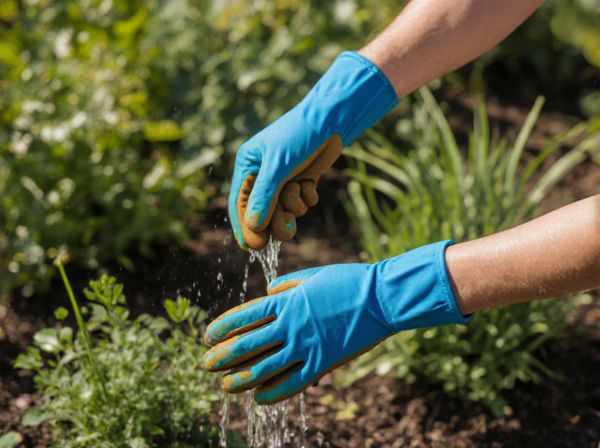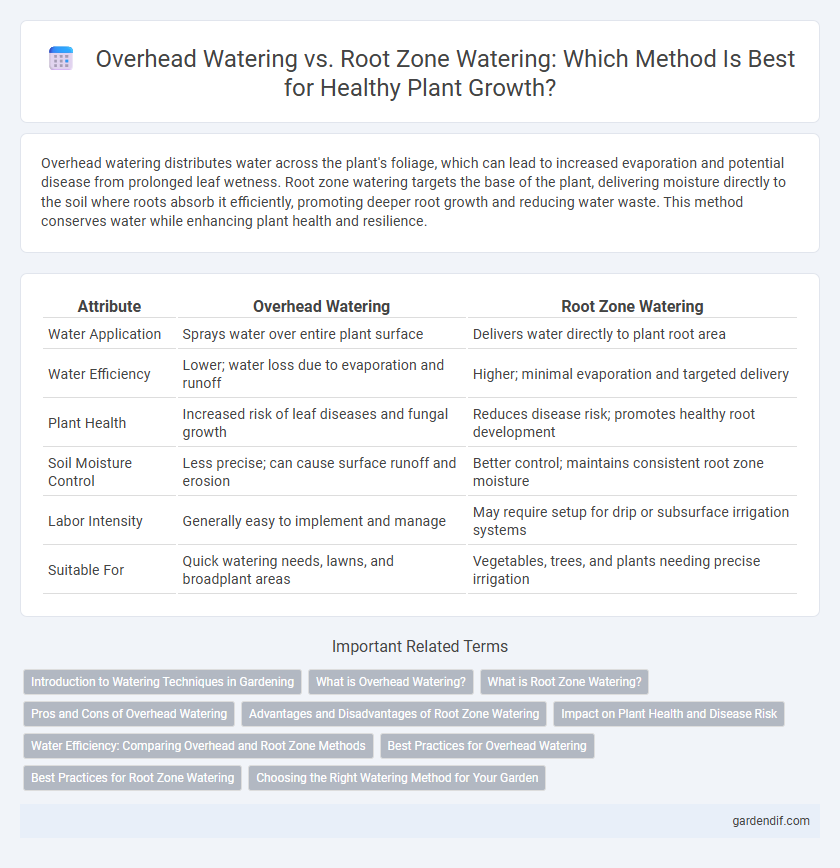
Overhead watering vs Root zone watering Illustration
Overhead watering distributes water across the plant's foliage, which can lead to increased evaporation and potential disease from prolonged leaf wetness. Root zone watering targets the base of the plant, delivering moisture directly to the soil where roots absorb it efficiently, promoting deeper root growth and reducing water waste. This method conserves water while enhancing plant health and resilience.
Table of Comparison
| Attribute | Overhead Watering | Root Zone Watering |
|---|---|---|
| Water Application | Sprays water over entire plant surface | Delivers water directly to plant root area |
| Water Efficiency | Lower; water loss due to evaporation and runoff | Higher; minimal evaporation and targeted delivery |
| Plant Health | Increased risk of leaf diseases and fungal growth | Reduces disease risk; promotes healthy root development |
| Soil Moisture Control | Less precise; can cause surface runoff and erosion | Better control; maintains consistent root zone moisture |
| Labor Intensity | Generally easy to implement and manage | May require setup for drip or subsurface irrigation systems |
| Suitable For | Quick watering needs, lawns, and broadplant areas | Vegetables, trees, and plants needing precise irrigation |
Introduction to Watering Techniques in Gardening
Overhead watering distributes water from above, mimicking natural rainfall and covering leaves, stems, and soil surface, which can increase evaporation and risk of fungal diseases. Root zone watering targets the base of plants, directing moisture directly to the soil and root system, promoting deeper root growth and reducing water waste. Effective gardening relies on understanding these techniques to optimize plant hydration and conserve water resources.
What is Overhead Watering?
Overhead watering involves applying water directly above plants using sprinklers or irrigation systems that disperse water like rainfall. This method covers a broad area and can be effective for lawns and larger garden beds but may increase water loss due to evaporation and cause foliage diseases. Understanding the water distribution pattern and plant type is crucial for optimizing overhead watering efficiency.
What is Root Zone Watering?
Root zone watering delivers water directly to the soil area surrounding a plant's roots, promoting deep, efficient absorption and minimizing surface evaporation. This method targets moisture where it is most needed, enhancing plant health and conserving water resources compared to overhead watering, which sprays water over foliage and soil surface. By focusing irrigation below ground, root zone watering reduces runoff and limits weed growth, improving overall water use efficiency.
Pros and Cons of Overhead Watering
Overhead watering covers a large area quickly and helps cool plants during hot weather but can lead to water waste due to evaporation and runoff. It may increase the risk of fungal diseases by keeping foliage wet, making it less suitable for plants sensitive to leaf moisture. Despite its convenience, overhead watering often results in uneven water distribution compared to targeted root zone watering.
Advantages and Disadvantages of Root Zone Watering
Root zone watering delivers water directly to the plant's roots, increasing water use efficiency and reducing evaporation losses compared to overhead watering. This targeted approach minimizes leaf wetting, which can decrease the risk of fungal diseases and pest infestations. However, root zone watering systems may require higher initial installation costs and careful maintenance to prevent clogging and ensure uniform water distribution.
Impact on Plant Health and Disease Risk
Overhead watering can increase the risk of fungal diseases by keeping leaves wet for extended periods, which promotes pathogen growth and reduces photosynthesis efficiency. Root zone watering targets the soil directly, delivering moisture to the plant's root system, enhancing nutrient uptake and reducing leaf wetness that contributes to disease development. Consistently maintaining dry foliage through root zone watering improves overall plant health by minimizing stress and lowering the incidence of leaf spot, mildew, and other waterborne pathogens.
Water Efficiency: Comparing Overhead and Root Zone Methods
Root zone watering delivers water directly to the plant's base, minimizing evaporation and runoff, thus significantly improving water efficiency compared to overhead watering. Overhead watering exposes foliage and soil surface, often leading to water loss through evaporation and reduced absorption efficiency. Optimizing irrigation by targeting the root zone enhances water conservation and promotes healthier plant growth.
Best Practices for Overhead Watering
Overhead watering is most effective when done early in the morning to reduce evaporation and fungal diseases by allowing foliage to dry quickly. Using fine nozzles or sprinklers that evenly distribute water helps minimize runoff and ensures uniform soil moisture. Regularly checking water pressure and avoiding watering during windy conditions maximizes efficiency and promotes healthy plant growth.
Best Practices for Root Zone Watering
Root zone watering maximizes water efficiency by delivering moisture directly to the soil surrounding plant roots, which reduces evaporation and runoff common with overhead watering. Using drip irrigation or soaker hoses ensures precise water application, promoting deep root growth and healthier plants. Scheduling irrigation during early morning or late evening further minimizes water loss and enhances absorption at the root level.
Choosing the Right Watering Method for Your Garden
Root zone watering delivers moisture directly to the plant's base, promoting deeper root growth and reducing water waste through evaporation. Overhead watering mimics natural rainfall but often leads to surface runoff and increased risk of fungal diseases due to wet foliage. Selecting root zone watering enhances water efficiency and plant health, especially for drought-sensitive or deep-rooted garden species.
Overhead watering vs Root zone watering Infographic

 gardendif.com
gardendif.com